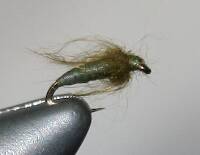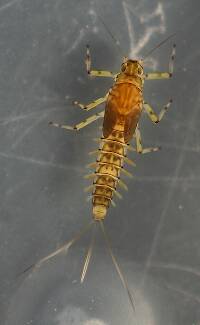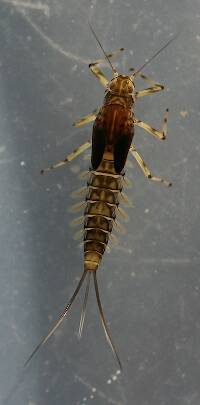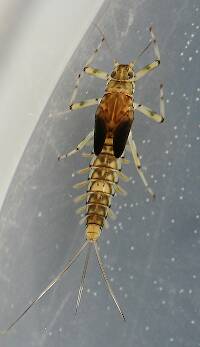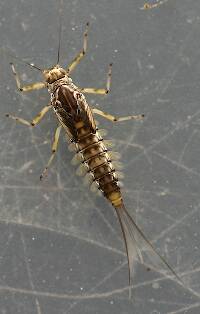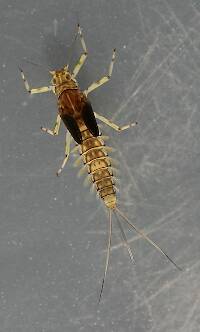
Hex Mayflies
Hexagenia limbata
The famous nocturnal Hex hatch of the Midwest (and a few other lucky locations) stirs to the surface mythically large brown trout that only touch streamers for the rest of the year.
Featured on the forum

This is an interesting one. Following the keys in Merritt R.W., Cummins, K.W., and Berg, M.B. (2019) and Jacobus et al. (2014), it keys clearly to Ephemerella. Jacobus et al provide a key to species, but some of the characteristics are tricky to interpret without illustrations. If I didn't make any mistakes, this one keys to Ephemerella mucronata, which has not previously been reported any closer to here than Montana and Alberta. The main character seems to fit well: "Abdominal terga with prominent, paired, subparallel, spiculate ridges." Several illustrations or descriptions of this holarctic species from the US and Europe seem to match, including the body length, tarsal claws and denticles, labial palp, and gill shapes. These sources include including Richard Allen's original description of this species in North America under the now-defunct name E. moffatae in Allen RK (1977) and the figures in this description of the species in Italy.

Troutnut is a project started in 2003 by salmonid ecologist Jason "Troutnut" Neuswanger to help anglers and
fly tyers unabashedly embrace the entomological side of the sport. Learn more about Troutnut or
support the project for an enhanced experience here.

This dun molted most of the way into a spinner (though the wings got stuck) the evening after I photographed it, so I took some more photos of the spinner.
I found a female nearby, probably of the same species.
I found a female nearby, probably of the same species.
Martinlf on Dec 23, 2006December 23rd, 2006, 12:21 pm EST
That sounds like some southern jive tune, doesn't it?
I seem to recall that we had a discussion about mayfly shucks a while back, in which we discussed the more opaque and dark coloration of invaria or rotunda shucks. These acerpenna shucks look much lighter, and greyish in color. Am I right? Are they also more translucent? What color are the nymphs, and what color Z=lon would you use to imitate a shuck on an emerger for this bug? Would this hold true for most baetids? This might explain the excellent luck I've had with the Little Lehigh olive emerger, (basically an RS2 design--see the Litle Lehigh Fly Shop website) which has a shuck of natural CDC that is fairly greyish in color.
Also, the first picture shows a clear difference in the color of the top and bottom of the abdomen, another good cue for dubbing color. Jason, these photos are amazing! I hope you have some luck with photos of emergers in the spring.
I seem to recall that we had a discussion about mayfly shucks a while back, in which we discussed the more opaque and dark coloration of invaria or rotunda shucks. These acerpenna shucks look much lighter, and greyish in color. Am I right? Are they also more translucent? What color are the nymphs, and what color Z=lon would you use to imitate a shuck on an emerger for this bug? Would this hold true for most baetids? This might explain the excellent luck I've had with the Little Lehigh olive emerger, (basically an RS2 design--see the Litle Lehigh Fly Shop website) which has a shuck of natural CDC that is fairly greyish in color.
Also, the first picture shows a clear difference in the color of the top and bottom of the abdomen, another good cue for dubbing color. Jason, these photos are amazing! I hope you have some luck with photos of emergers in the spring.
"He spread them a yard and a half. 'And every one that got away is this big.'"
--Fred Chappell
--Fred Chappell
GONZO on Dec 26, 2006December 26th, 2006, 12:28 pm EST
Louis,
The greyish shuck in the photos is the shed pellicle of the dun as the adult transforms into a spinner. The grey (dun) color reflects the duller coloration of the subimago and should not be taken as indicative of the nymphal shuck. I believe that most Acerpenna nymphs are brown to brownish-olive. Most mayfly shucks are more substantial and retain more color than caddisfly shucks. I assume this is because the exoskeleton has more of a protective/camouflage function for final stage mayfly nymphs than for caddisfly pupae (which transform into the pharate adult stage within a shelter). Of course, paler mayfly nymphs (like some burrowing nymphs) will have more translucent shucks (less pigment).
The greyish shuck in the photos is the shed pellicle of the dun as the adult transforms into a spinner. The grey (dun) color reflects the duller coloration of the subimago and should not be taken as indicative of the nymphal shuck. I believe that most Acerpenna nymphs are brown to brownish-olive. Most mayfly shucks are more substantial and retain more color than caddisfly shucks. I assume this is because the exoskeleton has more of a protective/camouflage function for final stage mayfly nymphs than for caddisfly pupae (which transform into the pharate adult stage within a shelter). Of course, paler mayfly nymphs (like some burrowing nymphs) will have more translucent shucks (less pigment).
Martinlf on Dec 27, 2006December 27th, 2006, 2:04 am EST
Duh. I don't know what I was thinking--or I was just not reading Jason's descriptions as I clicked around. Thanks again.
"He spread them a yard and a half. 'And every one that got away is this big.'"
--Fred Chappell
--Fred Chappell
Quick Reply
Related Discussions
Topic
Replies
Last Reply
2
Jul 2, 2009
by DayTripper
by DayTripper



